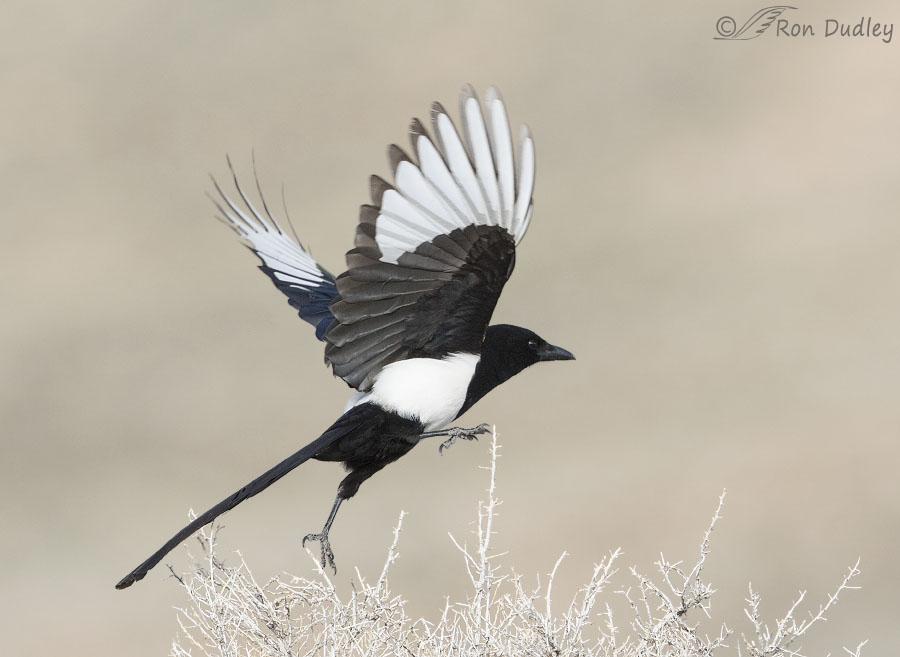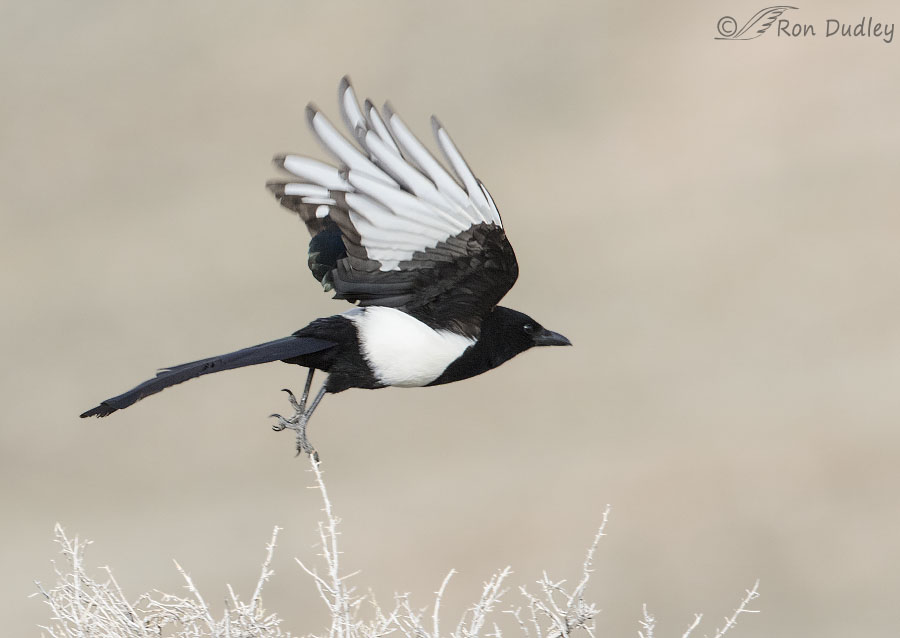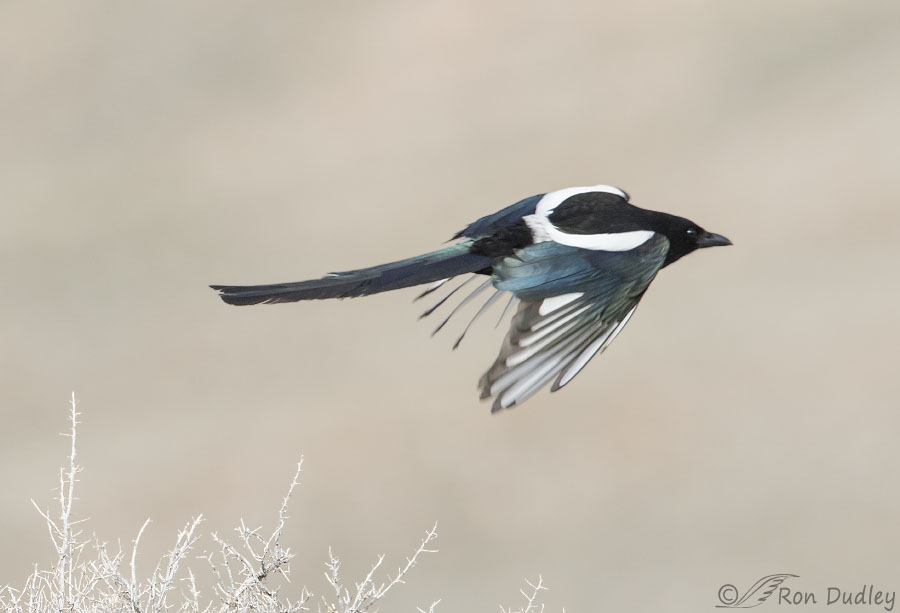It wasn’t much of an assist but just the fact that the magpie could/would do it for so little gain amazed me. These three photos are only of mediocre quality but I was happy to get them as documentation of an unexpected and impressive behavior.

1/2000, f/7.1, ISO 800, Canon 7D Mark II, Canon EF 500mm f/4L IS II US, not baited, set up or called in
This Antelope Island Black-billed Magpie had been perched on the far left side of the greasewood bush when it took off to my right. There was a flimsy vertical twig directly in front of the bird that I didn’t give a second thought but the magpie perceived it as either a potential obstacle or a tool to aid in quickly gaining elevation and momentum. Or perhaps both.
The magpie leaped forward at a steep angle and reached upwards with its foot as far as was physically possible to somehow deal with the tip of the twig. It appears that the bird might be about to push the twig out of the way but I don’t believe that’s what happened. Notice that the magpie isn’t even looking at the twig which is below and probably past its field of view so at this point it has to rely on memory, quick reflexes and athleticism to deal with the twig with its right foot.

1/2000, f/7.1, ISO 800, Canon 7D Mark II, Canon EF 500mm f/4L IS II US, not baited, set up or called in
It didn’t push the flimsy twig out of the way, instead it appeared to use it as a tool to gain elevation and momentum by placing a single toe on its tip and pushing upward and forward. Notice that the twig is slightly bent and pushed backward by the weight of the bird. The athleticism, dexterity and spatial awareness required to perform that little trick in the wink of an eye without even being able to see it at the moment of contact really impressed me.
The amount of vertical and forward momentum gained from such a flimsy twig must have been minimal and the athleticism and precision required to hit the twig with the tip of its narrow toe at the incredible speed of takeoff made me do a double-take when I viewed these photos on my screen. Of course in the field I had no idea it had even happened because takeoffs are just too fast to notice such things.

1/1600, f/7.1, ISO 800, Canon 7D Mark II, Canon EF 500mm f/4L IS II US, not baited, set up or called in
A split-second later the magpie was on its way and the twig had sprung back to its original shape.
I’m beginning to think that human observers are completely unaware of many impressive displays of athleticism and coordination that occur right before our eyes – and not just from birds. I once photographed a mule deer jumping a barbed wire fence that performed a stunt very similar to this one – here’s a link of you’re interested.
If you haven’t seen it before I think it’s worth the trip.
Ron
PS – Some viewers might think I’m making a mountain out of a mole-hill by featuring this maneuver on my blog and that’s OK. But little things like this often grab my attention and I find them fascinating. The more we know about our subjects the better, IMO.


Wonderful series Ron!
Charlotte
That is SO cool! I love it when you capture something totally incredible and unexpected like this. As my dad would have said, “Neato torpedo!” (at least if he was in a G-rated mood). 😉
The last shot with the white horseshoe pattern on the back, the white on the wings and the iridescence is a beaut!
I think I’d have liked your dad, Marty, in a G-rated mood or not. 🙂
I think the two of you would have gotten along quite well. He was a “unique” science teacher too (like father like daughter for me). 😉
When it comes to successful evolutionary progress (=improved fitness) aren’t the mole hills really the mountains? A wee behavioral adjustment here. a tiny morphological advantage there and given enough time a significantly different organism emerges. I just think it is great that we mere mortals now have access to all the powerful technical tools–fast digital cameras and powerful lenses, for example–on which to hone our skills and capture this level of detail. And a highly skilled and motivated “amateur”, I’d argue, may be even more likely to notice something “small” than a jaded professional lulled into the belief that they have seen and know it all. I am constantly amazed at the behavioral details you capture and highlight in your shots.
More mole hills! More mole hills!
Ha, enough mole hills could eventually resemble a mountain, James! You make some interesting points. Thank you.
‘Look after the pennies and the pounds will look after themselves’.
Those impressive skills that every bird needs have to be honed, refined, perfected.
Awe and wonder fill me at just how well they do it – and make it seem effortless.
I am so very grateful that your camera captures these things and that your inquiring mind sees and shares them.
“Those impressive skills that every bird needs have to be honed, refined, perfected.”
Perhaps that’s why he did it, EC. And just because he could…
Ron, I find that you sometimes don’t know what you’ve captured something quite amazing until you get home to review your images quite interesting. How often does that happen?
The Magpie takeoff using that twig is quite remarkable. What a beautiful bird.
The deer jumping over the barbed wire fence made me hold my breath until the last photo. What a feat it is for them to be able to do so. I did not choose to google anything related to unsuccessful deer attempts.
Thank you, Ron
“How often does that happen?”
It happens often enough to make image culling and review significantly less painful, Alice. I’m grateful for that.
At first I wondered if he might be just trying to avoid ruffling his fabulously groomed breast feathers, but if that was the case, why not just go a slightly different direction? Maybe he was just showing off. I would, if I was capable of such a move!
“Maybe he was just showing off”.
If it was I was duly impressed, Porcupine!
It’s fascinating to see this, Ron. I really enjoy these deeper insights into things I might not notice or be able to notice So thank you for that, professor. 😀
Thanks very much, Arwen.
To me, most of the wonder of life as it has evolved over untold time is to be found in EXACTLY these kinds of “molehills”—-I’m gratified to be able to see such details through the miracle
of high-speed photography —but even then it would go unnoticed but for the kind of caring observer –you– who values bio-knowledge as much as technical accomplishment . Thanks !
I especially appreciate the last part of your comment, Kris. Thank you.
I’ve concluded that SO much happens out there that we don’t see (and thus, don’t know) in those microseconds that it’s just ridiculous! Our eyesight is so darn slow, and when connected to our comparatively dullard brains, well, there you have it. Thankfully, photography can slow everything down in those micro slivers of time. Otherwise, we’d REALLY be clueless! 😉
I love magpies and the whole darn corvid family! Wish we had more here, but the crows and ravens have finally returned with the vultures. I missed them!
We’re still looking for our first vultures of the season. Thought we saw one this morning but we were mistaken.
The vultures are on their way back to you Ron! I know I missed them–the sky just seemed empty without them. I love vultures!
Hello Ron, I am new to your blog but you are so right, the more we know the better. As a birdwatcher I don’t see those things, most of the time, so your photos make me see what I am missing. And No, your are not making a mountain out of a mole-hill 😀!
Thank you
Welcome to Feathered Photography, Rose. And thank you.
Thanks for this fun series Ron. Especially love that first shot reaching up for the twig. I’m beginning to think that humans are completely unaware of much more than I ever would have thought, apart from observers missing fast action details like these. Its a great reward to carefully look through rapid burst images and see all that is there which we otherwise just don’t see well at all.
I agree, Dave – humans in general tend to be pretty dense. Thank you,
Impressive! Magpies are talented birds for sure as are many others! 🙂 Fences & deer/antelope are a challenge with some jumping, some crawling through with damage to both critters and fences at times. Always sad for the critter that gets caught and a REAL challenge to free one if caught in time. Chinook for a day yesterday and a March “squall” last night putting a coat of ice/snow on everything. Spring will come………..
Thanks, Judy. Ahhh, those fickle Montana springs…
What happens in nature within the span of one second, can leave us speechless. Those unexpected captures are powerful motivators that keep our face pressed against the back of a camera, for more hours that we care to admit. The foot positions in the first two exposures are perfect testament to why photographers continue to photograph the same subjects for years and years. Those are really insanely perfect micro-moments in time!
Everett, Truth be told one of the primary draws for me with bird photography is unexpectedly finding little gems like this when I’m reviewing images. It makes culling images slightly less painful… 🙂